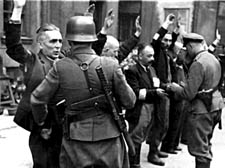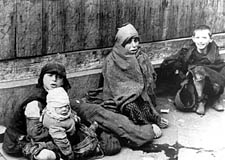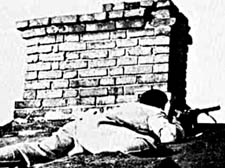|
|
 |
| |

German soldiers checking Jewish residents of the Warsaw
Ghetto

Poverty-stricken inhabitants of the Warsaw Ghetto.

A member of the Jewish resistance snipes at the German
army |
The secret world under the noses of the
Nazis
The most famous attempt
by Jews to resist the Nazis in armed fighting occurred in the
Warsaw ghetto, writes David Rosenberg
Five Years in the Warsaw Ghetto
by Bernard Goldstien
AK Press/Nabat Books, £13
JUST weeks before the Nazi army burnt the Warsaw Ghetto to a
cinder, and flushed out the last heroic resisters an acquaintance
of mine, and her twin sister, were smuggled over the wall.
Barely 11 years old, they were hidden by Catholics on the ‘Aryan
side’ of Warsaw and later by poor peasants risking death
sentences to shelter Jews.
This peasant family resolutely shared their last pieces of bread
with their guests, yet, the father regularly voiced anti-semitic
beliefs. Israel’s former premier, Yitzhak Shamir, infamously
claimed that “Poles imbibe antisemitism with their mother’s
milk”. Certainly, the Polish-Jewish encounter has been
replete with paradoxes.
Poland’s medieval monarchs welcomed Jews, granting them
unprecedented liberties while their cousins suffered persecution
in Western Europe.
In 1170 Warsaw’s Jews administered the Polish mint and
early Polish coins bore Hebrew inscriptions. At the outbreak
of World War II, one in ten Poles were Jews; in urban Warsaw
and Lodz the proportion was one in three.
After centuries of coexistence, though, many Jews today view
Poland only as a Jewish graveyard. The Nazis sited most of their
death camps in Poland and deported Jews there from other countries.
Of the six million Jews the Nazis murdered, more than four million
drew their last breath on Polish soil.
Bernard Goldstein’s riveting and poignant memoir, written
originally in Yiddish in 1947, when his wounds were still raw,
challenges the myths that a politically skewed hindsight has
nurtured – that all Poles betrayed the Jews, that Jews
went like lambs to the slaughter, and only the Zionists foresaw
the calamity that the Jews faced.
Goldstein recounts his story both as an observer and as an activist.
When the ghetto was established, he was 50-years-old –
and a trade union organiser esteemed by Jewish and non-Jewish
workers alike.
Smuggling himself in and out of the ghetto, he collaborated
with non-Jewish comrades to procure arms for ghetto fighters,
swap illegal newspapers with the Polish underground resistance
and maintain contact with other ghettoes
His political party was the Bund – a secular Jewish workers’
movement that swept the Jewish vote in elections to town councils
and Jewish community councils in the maelstrom of 1930s Poland.
Its
strongest suit was spearheading the fight against anti-semitism,
confronting discrimination which excluded Jews from many jobs,
and directly combating
street-level anti-Jewish violence.
Goldstein led the Bund’s self-defence militia in Warsaw
and cooperated closely with Polish Socialist Party militants.
The Bund opposed rabbis who counselled Jews to trust their fate
to God, and Zionists who disdained the daily fight against anti-semitism
to concentrate on recruiting a young, fit elite for emigration
to Palestine.
The most painful episodes of anti-semitism Goldstein encountered
and observed, occurred in 1945, as the anti-Nazi war ended and
ravaged people fought each other for personal survival. Yet
his own endurance through five years of Nazi occupation would
have been impossible without assistance from courageous non-Jewish
Poles.
Goldstein acknowledges that people of every nation could descend
to appalling depths in an “atmosphere of terror…and
complete human demoralisation” when “every decent
instinct was choked off”.
He had, after all, witnessed fellow ghetto inhabitants joining
the Jewish police and zealously hunting other desperate Jews
at the Nazis’ behest.
In the 21 months between the destruction of the Warsaw Ghetto
and Poland’s liberation, Goldstein was one of 500 Jews
who, incredibly, maintained an underground existence within
Warsaw, many hidden by sympathetic Poles. From their rabbit
holes, Goldstein and others endeavoured to support several thousand
more Jews surviving similarly on Warsaw’s outskirts. He
was periodically hidden by the half-Polish, half-German Chumatovsky
family. While Mrs Chumatovsky sheltered a prominent organiser
of the Jewish underground resistance, her older brothers, raised
in Germany, were fighting as Nazi soldiers.
Though he portrays situations of unbearable horror, Goldstein’s
memoir is ultimately uplifting because he demonstrates the ingenuity
by which people found ways to support each other in terrible
circumstances. Secret schools, libraries, orphanages and soup
kitchens were set up within the ghetto. Tenement committees
collectively employed engineers and builders to create hidden
doors, secret passages and cellars as hiding places to thwart
deportation by the Nazis.
Goldstein comments sardonically: “With great sacrifice
we managed to perform pathetic wonders”.
This sacrifice was not in vain. His testimony gives strength
to those who, albeit in a modest way, are rebuilding Jewish
life in Poland today.
In recent years I have encountered increasing numbers of Poles
who feel the depth of Poland’s loss, not only of Jews but
of inter-war Poland’s vibrant mix of that included Lithuanians,
Ukrainians, Germans and Gypsies too.
Although Poland’s political climate has recently swung
rightwards, these Poles continue to strive for the kind of Poland
that Bernard Goldstein was proud to be a part of.
• |
|
 |
|



